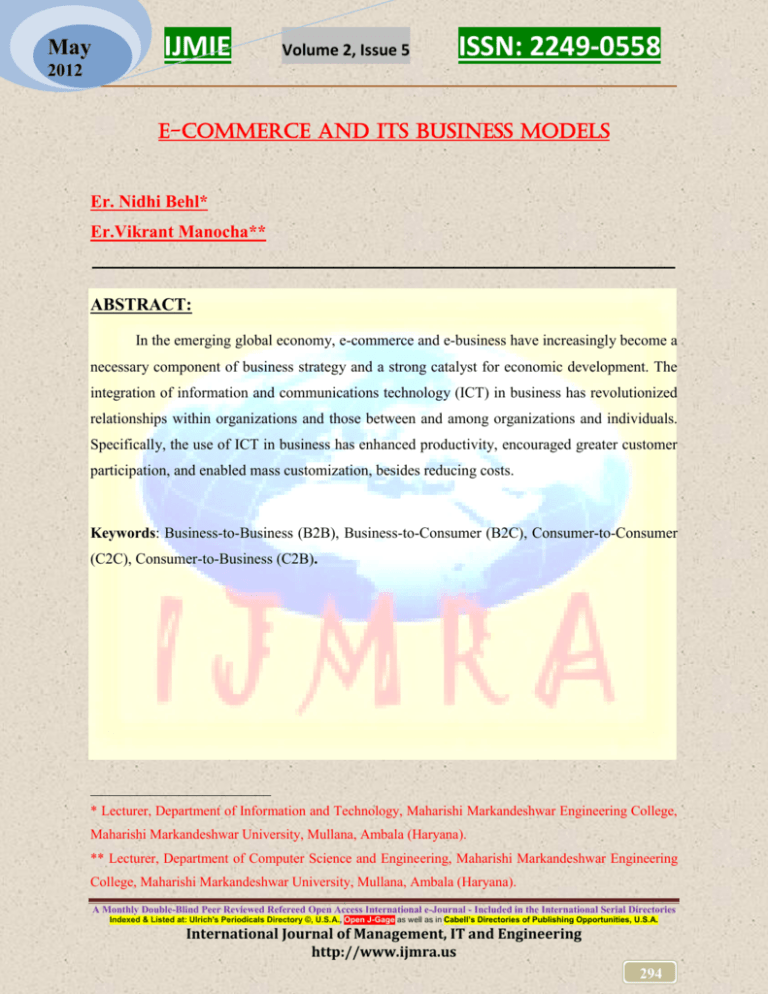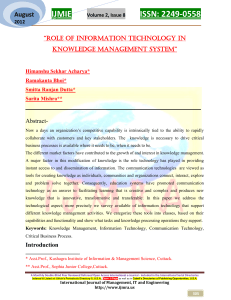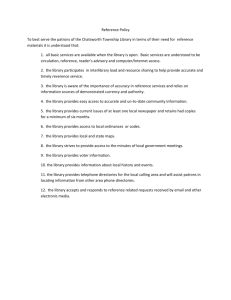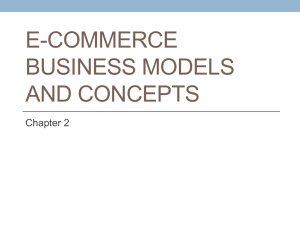Mitigation of Denial of Service (DoS) Attack
advertisement

May IJMIE Volume 2, Issue 5 ISSN: 2249-0558 2012 ___________________________________________________________ E-Commerce and its Business Models Er. Nidhi Behl* Er.Vikrant Manocha** __________________________________________________________ ABSTRACT: In the emerging global economy, e-commerce and e-business have increasingly become a necessary component of business strategy and a strong catalyst for economic development. The integration of information and communications technology (ICT) in business has revolutionized relationships within organizations and those between and among organizations and individuals. Specifically, the use of ICT in business has enhanced productivity, encouraged greater customer participation, and enabled mass customization, besides reducing costs. Keywords: Business-to-Business (B2B), Business-to-Consumer (B2C), Consumer-to-Consumer (C2C), Consumer-to-Business (C2B). * Lecturer, Department of Information and Technology, Maharishi Markandeshwar Engineering College, Maharishi Markandeshwar University, Mullana, Ambala (Haryana). ** Lecturer, Department of Computer Science and Engineering, Maharishi Markandeshwar Engineering College, Maharishi Markandeshwar University, Mullana, Ambala (Haryana). A Monthly Double-Blind Peer Reviewed Refereed Open Access International e-Journal - Included in the International Serial Directories Indexed & Listed at: Ulrich's Periodicals Directory ©, U.S.A., Open J-Gage as well as in Cabell’s Directories of Publishing Opportunities, U.S.A. International Journal of Management, IT and Engineering http://www.ijmra.us 294 May IJMIE Volume 2, Issue 5 ISSN: 2249-0558 2012 ___________________________________________________________ 1. INTRODUCTION OF E-COMMERCE: The Internet has created a new economic ecosystem, the e-commerce marketplace, and it has become the virtual main street of the world. Providing a quick and convenient way of exchanging goods and services both regionally and globally, e-commerce has boomed. Electronic commerce, commonly known as e-commerce, ecommerce or e-comm., refers to the buying and selling of products or services over electronic systems such as the Internet and other computer networks. However, the term may refer to more than just buying and selling products online. It also includes the entire online process of developing, marketing, selling, delivering, servicing and paying for products and services. The amount of trade conducted electronically has grown extraordinarily with widespread Internet usage. The use of commerce is conducted in this way, spurring and drawing on innovations in electronic funds transfer, supply chain management, Internet marketing, online transaction processing, electronic data interchange (EDI), inventory management systems, and automated data collection systems. Modern electronic commerce typically uses the World Wide Web at least at one point in the transaction's life-cycle, although it may encompass a wider range of technologies such as e-mail, mobile devices and telephones as well. Figure 2: Basic structure of e-commerce with its interfaces A Monthly Double-Blind Peer Reviewed Refereed Open Access International e-Journal - Included in the International Serial Directories Indexed & Listed at: Ulrich's Periodicals Directory ©, U.S.A., Open J-Gage as well as in Cabell’s Directories of Publishing Opportunities, U.S.A. International Journal of Management, IT and Engineering http://www.ijmra.us 295 IJMIE May Volume 2, Issue 5 ISSN: 2249-0558 2012 ___________________________________________________________ 2. Business Models of E-commerce: Ecommerce business models are the fundamental methods that show how an e-business makes money online. These are called all sorts of things by many different people on all kinds of web sites, infact there is a lot of confusion around these online business models. This is because they are an evolution of the more conventional brick and mortar business models. Although Ecommerce business models have their origins out in the real world, they have adapted and evolved to suite the environment they are in: the Internet. Most successful web sites do not fall into just one of these models, instead they utilize a combination of the e-business models to create great success. This is what I intend to describe, the ways in which you can use these different Ecommerce business models to your advantage, and create success for your online business. The first step in the development of an e-commerce site is to identify the e-commerce model. Depending on the parties involved in the transaction, e-commerce can be classified into 4 models. Business-to-Business (B2B) is one of the major forms of e commerce. Here the seller and the buyer participate as business entities. Here the business is carried out the same way a manufacturer supplies goods to a wholesaler. Business-to-Consumer (B2C) in this case transactions take place between consumers and business houses. Here individuals are also involved in the online business transactions. Consumer-to-Consumer (C2C) model is applicable when the business transaction is carried between two individuals. But for this type of e commerce, the individuals require a platform or an intermediary for business transactions. Consumer-to- Business (C2B) model involves a transaction that is conducted between a consumer and a business organization. It is similar to the B2C model, however, the difference is that in this case the consumer is the seller and the business organization is the buyer. In this kind of a transaction, the consumers decide the price of a particular product rather than the supplier. A Monthly Double-Blind Peer Reviewed Refereed Open Access International e-Journal - Included in the International Serial Directories Indexed & Listed at: Ulrich's Periodicals Directory ©, U.S.A., Open J-Gage as well as in Cabell’s Directories of Publishing Opportunities, U.S.A. International Journal of Management, IT and Engineering http://www.ijmra.us 296 May IJMIE Volume 2, Issue 5 ISSN: 2249-0558 2012 ___________________________________________________________ 1. Business-to-Business (B2B) Model These are, generally, larger companies that are supplying merchandise to smaller businesses who then sell it to their customers. Manufacturers, who are selling in large quantities, are a good example of this. Consider a hypothetical example. ABC Company sells automobile parts and XYZ company assembles these part and then sells the automobile to customers. XYZ Company comes across the Web site of ABC and finds it suitable. XYZ therefore, requests for more information about ABC and finally, decides to purchase automobile parts automobile from ABC. To do this, XYZ places an order on the Web site of ABC. After ABC receives the order details, it validates the information. As soon as the order is confirmed, the payment procedures are settled. Finally, ABC sends an acknowledgement of payment to XYZ and delivers the goods as per the shipment details decided between the two organizations. Figure 2: Business-to-Business Business Models Figure 2, the traditional business model for business-to-business operations involves a procurement staff that negotiates with various suppliers. For example, a bookstore may procure books from several distributors and office supplies from one or more other suppliers. In the ecommerce business model, a procurement staff (typically smaller than the staff necessary in the traditional business-to-business model) shops online for supplies and other items necessary to the business. Just as it does for the consumer in the business-to-consumer business model, the A Monthly Double-Blind Peer Reviewed Refereed Open Access International e-Journal - Included in the International Serial Directories Indexed & Listed at: Ulrich's Periodicals Directory ©, U.S.A., Open J-Gage as well as in Cabell’s Directories of Publishing Opportunities, U.S.A. International Journal of Management, IT and Engineering http://www.ijmra.us 297 May IJMIE Volume 2, Issue 5 ISSN: 2249-0558 2012 ___________________________________________________________ Internet allows businesses to comparison shop online in order to find the most appropriate product at the best price. This reduces many of the front-end costs for finding goods and products that are incurred in the traditional model. Advantages of E-Commerce for B2B Businesses 1. Outsourcing the unprofitable parts of your business 2. Speeding up your product development activities – reducing time to market 3. Improved business and market intelligence. Understanding your market better than your competitors 4. Cloning your business in further markets 5. Improving the speed of communication 6. Facilitating communication between your customers and suppliers 7. Reducing wastage through additional sales channels 8. Improved ability to experiment and learn 9. Higher customer retention rates 10. Lower customer acquisition costs 11. Reduced costs can be passed on in favorable pricing 12. Its is cost reduction technique for the company so as to overcome mediator 13. With advancement in technology B2B can be done with the help of Electronic commerce. 14. With the help of online auction the buyer of industrial goods can get the product at a cheap deal, as there are many competitors in an online auction. 15. With E-Com electronic funds transfer-using EDI can be done between to organizations. 16. B2B helps in lowering the cost for selling and marketing. 17. It also shortens the selling cycle. A Monthly Double-Blind Peer Reviewed Refereed Open Access International e-Journal - Included in the International Serial Directories Indexed & Listed at: Ulrich's Periodicals Directory ©, U.S.A., Open J-Gage as well as in Cabell’s Directories of Publishing Opportunities, U.S.A. International Journal of Management, IT and Engineering http://www.ijmra.us 298 May IJMIE Volume 2, Issue 5 ISSN: 2249-0558 2012 ___________________________________________________________ 18. The most important advantage of B2B is to have JIT just in time delivery, the company can have the track of good as to which place it has reached with the help of electronic commerce. Disadvantage of E-Commerce for B2B Businesses 1. Number of B2B websites as early as 2000, there was an explosive growth. In order to obtain cheaper and faster delivery, it opened hundreds of websites to support the automotive, chemical, pharmaceutical, retail and other industries. E-commerce is not suitable for every business. 2. B2B is a problem in this type of business will lead to a possible lack of credit. For example, large electronics market owners may deliberately kill smaller competitors transactions. Electronic public bidding itself may lead to dubious price signals. 3. B2B process has often happened in the newspaper, telephone and face to face meetings. No one is given to ensure the success of B2B business model. Most sites charge a small fee per transaction as a percentage of revenue. Reason is competition. Moreover, the monopoly of a special service providers and enterprises are building for ten of his own trading platform products and industries. Business-to-Consumer (B2C) Model: The B2C model involves transactions between business organizations and consumers. It applies to any business organization that sells its products or services to consumers over the Internet. These sites display product information in an online catalog and store it in a database. The B2C model also includes services online banking, travel services, and health information. A Monthly Double-Blind Peer Reviewed Refereed Open Access International e-Journal - Included in the International Serial Directories Indexed & Listed at: Ulrich's Periodicals Directory ©, U.S.A., Open J-Gage as well as in Cabell’s Directories of Publishing Opportunities, U.S.A. International Journal of Management, IT and Engineering http://www.ijmra.us 299 May IJMIE Volume 2, Issue 5 ISSN: 2249-0558 2012 ___________________________________________________________ Figure 3:B2C Business Model of E-commerce The example of the www.amazon.com site involves the B2C model in which the consumer searches for a book on their site and places an order, if required. This implies that a complete business solution might be an integration solution of more than one business model. For example,www.amazon.com includes the B2B model in which the publishers transact with Amazon and the B2C model in which an individual consumer transact with the business organization. The B2C model of e-commerce is more prone to the security threats because individual consumers provide their credit card and personal information n the site of a business organization. In addition, the consumer might doubt that his information is secured and used effectively by the business organization. This is the main reason why the B2C model is not very widely accepted. Therefore, it becomes very essential for the business organizations to provide robust security mechanisms that can guarantee a consumer for securing his information. Using the latest internet application technology, individual sites can be created within minutes of the retailer selecting a template and supplying graphics such as logos. Typically, retailers will pay only a modest monthly rental charge – and retailers require no specialist hardware or software, other than internet access.Anyone who wants to sell products and services over the internet, or who wants customers to be able to research their purchases on the internet, should consider an online store. A Monthly Double-Blind Peer Reviewed Refereed Open Access International e-Journal - Included in the International Serial Directories Indexed & Listed at: Ulrich's Periodicals Directory ©, U.S.A., Open J-Gage as well as in Cabell’s Directories of Publishing Opportunities, U.S.A. International Journal of Management, IT and Engineering http://www.ijmra.us 300 IJMIE May Volume 2, Issue 5 ISSN: 2249-0558 2012 ___________________________________________________________ Advantages of E-Commerce for B2C Businesses Benefits of B2C e-commerce can be considered either from the viewpoint of the consumer or from that of the business. From the consumer side, benefits include: 1. Access to goods and services from the home or other remote locations. 2. The possibility of lower cost goods and services. 3. Access to a greater variety of goods and services on offer. 4. Convince. Consumers can shop at any time of day, from the privacy of their own home. The internet has been called “the mall that never sleeps.” 5. So many choices – Consumers can shop for basically any item they can think of! Airline tickets, groceries, clothing, and even medicine! 6. Less Hassle – Consumers can shop online without dealing with annoying sales people, fighting the congestion of shopping malls, and driving 10 different places to find one thing. From the business side, benefits include: 1. Lower transaction costs associated with sales. 2. Access to global markets and hence to more potential customers. 3. Opportunities for disc-intermediation leading to lower costs for customers. 4. Can reach worldwide market with unlimited volume of customers. 5. Can display information, pictures, and prices of products or services without spending a fortune on colorful advertisements. 6. 7. In some cases, makes order processing an easier task than before. Can operate on decreased, little, or even no overhead. A Monthly Double-Blind Peer Reviewed Refereed Open Access International e-Journal - Included in the International Serial Directories Indexed & Listed at: Ulrich's Periodicals Directory ©, U.S.A., Open J-Gage as well as in Cabell’s Directories of Publishing Opportunities, U.S.A. International Journal of Management, IT and Engineering http://www.ijmra.us 301 IJMIE May Volume 2, Issue 5 ISSN: 2249-0558 2012 ___________________________________________________________ Disadvantage of E-Commerce for B2C Businesses 1. the competition is so fast for the web. There can literally be thousands of place a customer can go purchase the same product that you offer. 2. technology problem can cause you site to not operate properly, causing you to loose customers and sales. 3. Catalog Inflexibility: The catalog needs to regenerate every time when there is some new information or items to add in. 4. Limited Market Place: Normally, customer will only locally and limited to certain area. 5. High Sales Cycle: Usually, a lot of phone calls and mailings are needed. 6. Required Higher Cost of Doing Business: Cost regarding inventory, employees, purchasing costs, and order-processing costs associated with faxing, phone calls, and data entry, and even physical stores. Subsequently, increase transaction costs. 7. Inefficient Business Administration: Store inventory levels, shipping and receiving logs, and other business administration tasks might need to be categorized and updated manually in and done only when have time. This cause the information might not the latest or updated. 8. Need to employ number of staff: Need staffs that give customer service and sales support service. Disadvantages for the consumer 1. Security issue: probably the number one reason why people don’t purchase online. Credit card information is very sensitive and must be handled by someone the customer can trust.Scams, frauds and rip-off are not uncommon on the web. 2. Customer services: consumer are not always satisfied with their purchases and when buying online. They offer don’t get the answer they need in a timely manner they demand. Consumer to consumer (C2C) Model: The C2C model involves transaction between consumers. Here, a consumer sells directly to another consumer. EBay and www.bazee.com are common examples of online auction Web A Monthly Double-Blind Peer Reviewed Refereed Open Access International e-Journal - Included in the International Serial Directories Indexed & Listed at: Ulrich's Periodicals Directory ©, U.S.A., Open J-Gage as well as in Cabell’s Directories of Publishing Opportunities, U.S.A. International Journal of Management, IT and Engineering http://www.ijmra.us 302 May IJMIE Volume 2, Issue 5 ISSN: 2249-0558 2012 ___________________________________________________________ sites that provide a consumer to advertise and sell their products online to another consumer. However, it is essential that both the seller and the buyer must register with the auction site. While the seller needs to pay a fixed fee to the online auction house to sell their products, the buyer can bid without paying any fee. The site brings the buyer and seller together to conduct deals. Consumer-to-consumer (C2C) (or citizen-to-citizen) electronic commerce involves the electronically facilitated transactions between consumers through some third party. A common example is the online auction, in which a consumer posts an item for sale and other consumers bid to purchase it; the third party generally charges a flat fee or commission. The sites are only intermediaries, just there to match consumers. They do not have to check quality of the products being offered. Figure 4:C2C Business Model of E-commerce Let us now look at the previous figure with respect to eBay. When a customer plans to sell his products to other customers on the Web site of eBay, he first needs to interact with an eBay site,which in this case acts as a facilitator of the overall transaction. Then, the seller can host his product on www.ebay.com, which in turn charges him for this. Any buyer can now browse the site of eBay to search for the product he interested in. If the buyer comes across such a product, he places an order for the same on the Web site of eBay. eBay now purchase the product from the seller and then, sells it to the buyer. In this way, though the transaction is between two customers, an organization acts as an interface between the two organizations. A Monthly Double-Blind Peer Reviewed Refereed Open Access International e-Journal - Included in the International Serial Directories Indexed & Listed at: Ulrich's Periodicals Directory ©, U.S.A., Open J-Gage as well as in Cabell’s Directories of Publishing Opportunities, U.S.A. International Journal of Management, IT and Engineering http://www.ijmra.us 303 May IJMIE Volume 2, Issue 5 ISSN: 2249-0558 2012 ___________________________________________________________ Advantages of E-Commerce for C2C Businesses . Papal set up directly for this reason. 2. Broader market. 3. Eliminates intermediary. 4. Constantly changing, updating. 5. Always there so that consumers can use it whenever they want. Disadvantage of E-Commerce for B2C Businesses . No quality control 2. No payment guarantee 3. Hard to pay for using cheques, ATM, cards, etc. but future this is likely to change. Consumer-to-Business (C2B) Model: Consumer-to-business (C2B) is a business model in which consumers (individuals) create value, and firms consume this value. For example, when a consumer writes reviews, or when a consumer gives a useful idea for new product development, then this individual is creating value to the firm, if the firm adopts the input. Excepted concepts are crowd sourcing and co-creation. The C2B model involves a transaction that is conducted between a consumer and a business organization. It is similar to the B2C model, however, the difference is that in this case the consumer is the seller and the business organization is the buyer. In this kind of a transaction, the consumers decide the price of a particular product rather than the supplier. This category includes individuals who sell products and services to organizations. For example, www.monster.com is a Web site on which a consumer can post his bio-data for the services he can offer. Any business organization that is interested in deploying the services of the consumer can contact him and then employ him, if suitable. A Monthly Double-Blind Peer Reviewed Refereed Open Access International e-Journal - Included in the International Serial Directories Indexed & Listed at: Ulrich's Periodicals Directory ©, U.S.A., Open J-Gage as well as in Cabell’s Directories of Publishing Opportunities, U.S.A. International Journal of Management, IT and Engineering http://www.ijmra.us 304 May IJMIE Volume 2, Issue 5 ISSN: 2249-0558 2012 ___________________________________________________________ Figure 5:C2B Business Model of E-commerce Example of C2B is shown in figure.If you do exercise, you will have to pay monthly fee of Jim. Conclusion: Several important phenomena’s are associated with e-commerce. It has created the most significant revolution in the way business is conducted. New methodologies have evolved. The role of geographic distances in forming business relationships are reduced. Barriers to the entry into the retail businesses are lower, as it is relatively inexpensive to start a retail Website. Some traditional business intermediaries are being replaced by their electronic equivalents or are being made entirely dispensable. Prices of commodity products are generally lower in the Web, a reflection not merely of the lower costs of doing electronic business but also of the ease of comparison-shopping in cyberspace. What has flourished is a new form of corporate cooperation known as a virtual company, that is actually a network of firms, each performing some of the processes needed to manufacture a product or deliver a service E-commerce and the information technology that enables it allow organizations to conduct business together in new ways. Two revolutionary new business models that have come out of this movement are the business-to-business e-commerce models of Dell and Cisco, which support lean manufacturing and improve transaction efficiency. In addition, new models for A Monthly Double-Blind Peer Reviewed Refereed Open Access International e-Journal - Included in the International Serial Directories Indexed & Listed at: Ulrich's Periodicals Directory ©, U.S.A., Open J-Gage as well as in Cabell’s Directories of Publishing Opportunities, U.S.A. International Journal of Management, IT and Engineering http://www.ijmra.us 305 May IJMIE Volume 2, Issue 5 ISSN: 2249-0558 2012 ___________________________________________________________ business-to-business e-commerce continue to evolve as enterprises find new and creative ways to do business with each other. References: www.ecommerce-web-hosting-guide.com/ecommerce-business-model www.scribd.com/doc/2527149/Ecommerce-And-Its-Business-Model www.it.uom.gr/teaching/distrubutedSite/...ca/.../E-Comm_Models www.dejavusolutions.com/cms/index.php/white.../e-commerce?start www.ecomm4dev.org/DIWkPpr18.DOC www.etc corporate.org/resources/uploads/2_eCommerce-DMOs.pdf www.igi-global.com/article/international-journal-virtual.../2956 www.designersplus.co.uk/unit4/benefits_of_e_commerce/level3.html blogspot.com/.../advantages-and-disadvantages-of-b2c.html blogspot.com/.../advantages-and-disadvantages-of-b2c.html forbstudents.blogspot.com/.../advantages-and-disadvantages-of-c2c.html forbstudents.blogspot.com/.../advantages-and-disadvantages-of-c2b.html forbstudents.blogspot.com/.../advantages-and-disadvantages-of-c2c.h. forbstudents.blogspot.com/.../what-is-c2b-consumer-to-business.html A Monthly Double-Blind Peer Reviewed Refereed Open Access International e-Journal - Included in the International Serial Directories Indexed & Listed at: Ulrich's Periodicals Directory ©, U.S.A., Open J-Gage as well as in Cabell’s Directories of Publishing Opportunities, U.S.A. International Journal of Management, IT and Engineering http://www.ijmra.us 306








